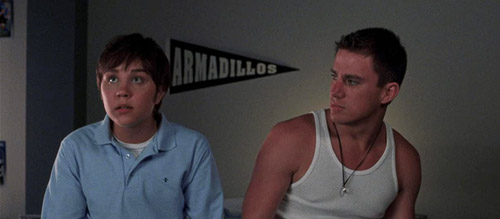She’s the Man (2006) – 15th Anniversary Review
She’s the Man (2006)
Director: Andy Fickman
Screenwriters: Ewan Leslie, Karen McCullah, Kirsten Smith
Starring: Amanda Bynes, Channing Tatum, Laura Ramsey, Vinnie Jones, Julie Hagerty, David Cross, Robert Hoffman, Alexandra Beckenridge, James Kirk, Robert Torti
Before the ceaseless cycle of sequels, remakes and superhero franchises, there was once a time when Hollywood attempted to trick us, via the medium of teen-comedy movies, into learning about classic literature and feminism. For a while, it really worked: Amy Heckerling’s Clueless (1995) modernised Jane Austen’s “Emma”, teaching us about gender politics by ensnaring us with popular ‘90s Valley Girls, daring fashion and catchy catchphrases; and with his debut feature 10 Things I Hate About You (1999), using unforgettable musical numbers and maddening teenage angst, Gil Junger duped us into studying gender roles within Shakespeare’s “The Taming of the Shrew”. Then, in 2006, came She’s the Man, an oddly progressive exploration of gender stereotypes, adapted from Shakespeare’s “Twelfth Night”.
Viola (Amanda Bynes), captain of the girl’s football team, is devastated when her team gets cut from Cornwall High’s curriculum. She appeals to the school’s coach (Robert Torti), arguing that she and her girls should be able to play on the boys team given that they are just as skilled as any of their male counterparts. ‘Boys are stronger,’ a gaggle of male footballers chuckle dismissively. Even Viola’s own boyfriend (Robert Hoffman), the team’s goalkeeper, refuses to entertain the idea of mixed-gender sport, leaving Viola no choice but to dump him on the spot and hatch a plan to prove them all wrong.
The perfect opportunity presents itself when Viola’s twin brother Sebastian (James Kirk) appeals for her help, asking her to cover for him at his new school while he flies to London for two weeks to tour with his band. The school happens to be Illyria Preparatory School, Cornwall’s crosstown rivals and biggest threat on the soccer field. So, with an idea cooking in her mind, Viola convinces her Mother (Julie Hagerty) that she will be staying at her Dad’s house for two weeks, then begs her friend Paul (Jonathan Sadowski) to transform her into a boy. With the help of a new wardrobe, a good wig, sticky-on sideburns and eyebrows, some lessons in how to walk and talk and spit like a guy, Viola impersonates her brother, takes his space at Illyria and plans to make it onto the football squad to beat the Cornwall boys and prove herself as the better player. The plan seems foolproof until Viola discovers that being a boy isn’t as simple as she’d assumed it would be. Plus, on top of all the social issues, itchy wig, and lack of shower time, Viola’s roommate Duke Orsino (Channing Tatum) turns out to be an impossibly gorgeous and very distracting hunk.
Like Clueless and 10 Things I Hate About You, She’s the Man performed exceptionally well at the box office. However, it also received the same shady put-downs from legions of male critics, who, god-forbid, should attempt to see the value in anything aimed at a female or teen audience. Critics seemed to take issue with Bynes’ interpretation of manhood – Viola bonds with the boys through slapping ass and talking about women like playthings – and how the film winds up with Viola embracing dresses, ‘ladylike behaviour’ and relationships in a way she seemed to have been rebelling against through the entire movie.
Returning to this film today and seeing it through eyes with a more nuanced understanding of gender, it seems as if the film’s real gender-bending agenda was actually to dismantle some of our perceptions of sex in relation to identity. Bynes’ over the top grunting, boyish movement and casual sexism aren’t painting a portrait of what men are; instead, they reveal how a young woman perceives the male gender through her lived experiences. In actuality, Duke and his friends seem to rebel against Viola’s lude talk of women and sex; Duke especially shows a vulnerability during the pair’s heart to heart chats, seeming to want a meaningful relationship above anything physical. The film also calls out gender performance to a certain extent, aiming to highlight the redundancy in how society expects men and women to behave. For example, Olivia falls for Viola as Sebastian, not because of her faux, stereotypical behaviour, but because Viola so often lets the mask slip around her, absentmindedly complimenting her shoes or fainting when asked to dissect a frog in science class. Scenes in which Viola’s Mum pressures Viola into behaving with poise and delicate politeness are also constructed around subversive comedy and reveal the absurdity of ‘ladylike’ behaviour: ‘Chew like you have a secret’, Viola’s mum whispers as Viola savagely rips meat from a chicken bone.
Through its exaggerated comedy, the film makes moves to break down ingrained ideas of gender performance. However, to a modern audience, accepting of gender as a spectrum, non-binary individuals and gender non-conformance, She’s the Man might feel like a bit of old news. During the big reveal, Viola and Sebastian flash their bodies to prove their gender, which feels like a dated concept given how we approach biological sex and gender identity in the modern world. Though progressive for 2006 audiences, the film explores its themes with a lightness of touch. Although it mildly hints at an LGBTQ+ relationship towards the end, the movie does little to address the heavy homoeroticism that it layers on thick throughout. It’s a real shame because even Shakespeare, who lived in the 16th Century, was daring enough to confront his audiences with a more substantial discussion of sexuality. When Duke discovers Viola’s gender in “Twelfth Night”, he continues to call her by her male name.
Most of the film’s comedy still holds up, although most of those triumphs belong to Amanda Bynes. Her delivery and physical comedy are unmatched when we compare her to contemporary comedy performers. She radiates the energy of a young Jim Carrey or Eddie Murphy, who carried their movies on performance alone. Channing Tatum, too, shows early comedic promise, which he would later go on to perfect in 21 Jump Street. Although She’s the Man was his first turn as the leading man, his performance is just as surefooted here as we saw in Magic Mike, Step Up and Logan Lucky.
Given the developing conversations around mental health alongside films such as Honey Boy and Framing Britney Spears, which look at the ramifications of celebrity on young performers, it feels challenging to look back on Bynes’ career. Bynes struggled significantly in the public eye, but rather than greeting her with concern, the internet made a meme of her, and the media seemed to relish in punishing her. Hopefully, the reaction would be different if a similar situation arose today, but it still stings to think about how much our ignorance played a part in her struggles.
Ultimately, She’s the Man is still terrific fun. Those classic gags hit just as swiftly as they did in 2006, and Bynes’ ‘boy’ costume has aged surprisingly well. Although silly and exaggerated, Bynes crafts her dual characterisation work so well that it’s easy to forget she exists underneath her disguise. Plus, the film radiates inviting Noughties nostalgia, delivering not one but two All American Rejects tracks (“Dirty Little Secret” and “Move Along” – an added surprise treat). She’s the Man is just as enjoyable as ever and a reminder that we should probably start thinking about teen movies with a little bit more respect.
Perhaps we didn’t all grow up to be Shakespearean scholars, but nice try anyway, Hollywood.
19/24



